In this post, I’ll write about my experiment with Google AdSense, with a very brief explanation of what AdSense is. Note: I’m not an AdSense or website monetization expert, but here I’ve provided metrics and an explanation of how I’ve measured. Convinced that the info as such (objective) can help both experts and amateurs – it is certainly valuable to me. Because I’ve found too much guesswork and hearsay on the Internet (not just on this topic).
If viewing this page with an AdBlocker enabled, some images (containing the word “AdSense” in the description, and/or filename) could be blocked. I’ve just noticed this with AdGuard AdBlocker. 🙂
In separate articles, I explained other ways of website monetization and shared my experience with an AdSense alternatives: Setupad, Mediavine (and Raptive – former AdThrive – onboarding process only).
Update, 2022, September:
I have completely switched to Mediavine website monetization platform.
Briefly put: it lets me limit how many in-article ads are shown per page, it’s very well optimized in terms of page-load speed, and it provides over five times higher revenue compared to AdSense.
Update, 2023, November:
Google have greatly improved the advert displaying controls, and are starting to pay per view (see chapter 16 of this article for more details).
Status: passive
I tested/used the service from January 2016 – to September 2022
1. What is Google AdSense?
Shortly: it is a program for showing adverts on a website. Companies pay Google for advertising, Google chooses which ads are shown on which website and gives a part of that commission to the website owners. Commission depends on the type and number of shown ads, as well as on whether the ads are clicked on by website visitors.
2. How to apply
Go to Google AdSense page and register. You will need a Gmail account and a website with enough good quality, unique content.
After providing all the needed data, you will get a snail mail letter, with a code – which you will enter to AdSense account once you receive it, in order to confirm you have provided a real address.
In this post, I won’t be explaining the technique of placing ads on the website – instructions for that are in my article about how to add Google AdSense to a WordPress site?
3. My initial setup of AdSense ads
I originally placed ads on the right hand side column, below all the menu options.
These ads were invisible for visitors using mobile phones (only after reading an entire article would they get to the ads section).
At the start of 2019 I added a small banner on top, that is also shown on top to visitors with mobile phones. At about the same time, I implemented AMP page versions, with ads included.
An interesting thing about AMP pages is they are “immune” to ad blockers, so ads are always shown on them. Downside is that Google chooses where to place those ads on AMP pages (which is good for earnings, but you can’t design the layout).
If you’re interested:
Here is how the ad layout looks like:
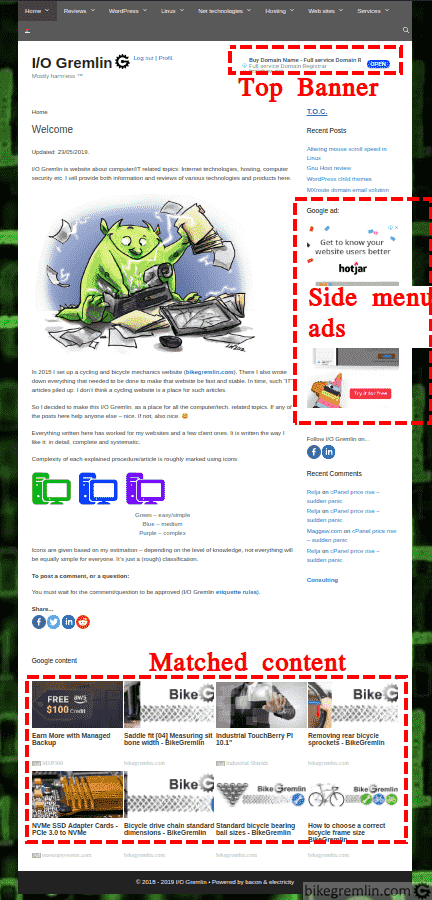
Picture 1
This drastically increased earnings from ads, much more than the rise in the number of visitors. Graph of monthly ad earnings change from month to month:
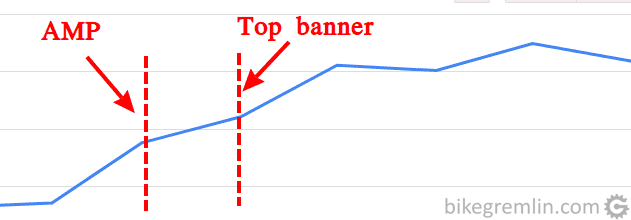
Picture 2
Overview of the ad revenue that each ad position has made in a month, relative to other ad positions:

Picture 3
It is interesting to note that the cycling website in English, with most visitors from USA and UK, earns a lot more money per visitor (RPM) than the cycling website in Serbocroatian, where most visitors come from former Yugoslavia. While this website, with computer related topics, makes even more revenue per one visitor:
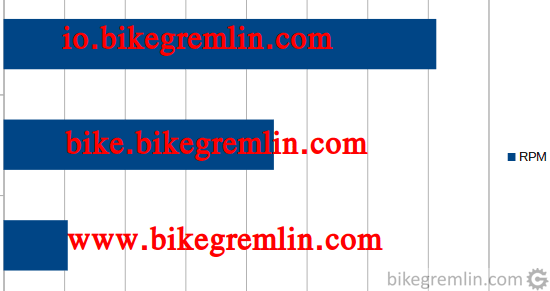
io.bikegremlin.com (computers)
bike.bikegremlin.com (cycling in English)
www.bikegremlin.com (cycling in Serbocroatian)
Picture 4
If I calculate revenue per click on an ad (AdSense pays only for clicks), this is the average:
- IT-related content (with mostly US visitors clicking): 50 cents per click.
- English bike-related content (again, mostly US visitors): 25 cents per click.
- Bike-related content in my native (ex-Yugoslavia visitors): 4 cents per click.
4. AdSense experiment
The plan is to, starting from September 2019, let Google automatically place ads where it thinks it is best to place them, then see if there are any significant revenue changes. The experiment will be let to run for two months. I will be following the changes in both revenue and the number of monthly visitors.

Picture 5
I’ll also be visually checking what it looks like (for me) on the pages: is it too crowded with ads, or are there even fewer of them.
5. First impressions – September
Subjective impression is there are more adverts on websites. What bothers me the most (what I hate) are the ads inserted between paragraphs of a page. As for the metrics, I haven’t noticed a drop in the number of visits, nor shorter duration of visits. Will be monitoring this, as well as whether Google, after the experimenting is done, reduces the number of adverts, keeping only a few that pay best, in places where they give the best results.
Normalized stats for RPM and total website income compared for August and September (the experiment was started on September 1st):
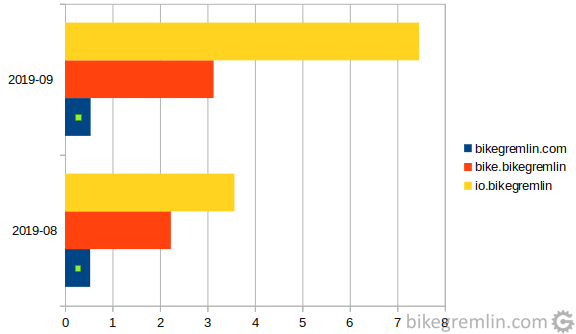
Picture 6
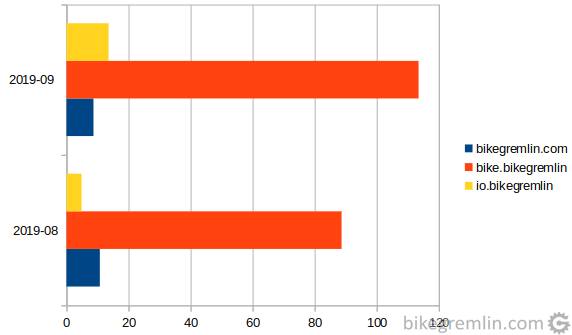
Picture 7
RPM of io.bikegremlin.com leads to a conclusion that adverts on computer websites are paid a lot more than ads on cycling websites.
The fact that the English version of the cycling website makes over 10 times more revenue than the Serbocroatian version, while it has only 5 times more visitors, leads to a conclusion that the ads served to visitors from the US and EU pay a lot more than those served to the visitors from Serbia, Croatia, Bosnia and the other countries from the region.
In those terms, which is not shown on the graphs, practically all the income generated by this website (io.bikegremlin.com) comes from the US visitors. If the structure of visitors changes in the future, so that majority come from Serbia, it should, based on the above stated stats and conclusions, drastically decrease website’s RPM.
Will update this article after the October is through with new stats.
6. Second month of testing – October
In the second month of testing I added a variation to the experiment. I.e. added another experiment. In Google AdSense options, I set so that every second visitor sees only 65% of the available ads – those that are most relevant and most highly paid. As the graphs below show, this resulted in a symbolic drop in total earnings. Only the computer website (this one) saw a drastic drop in both earnings and RPM.
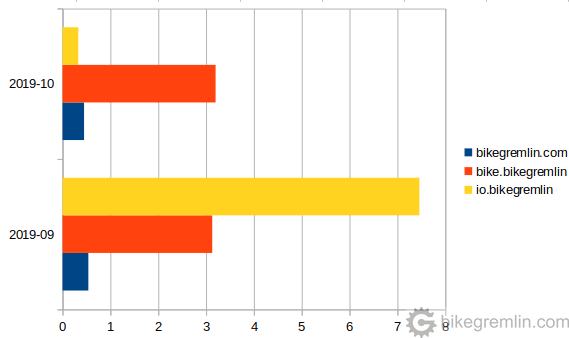
Picture 8
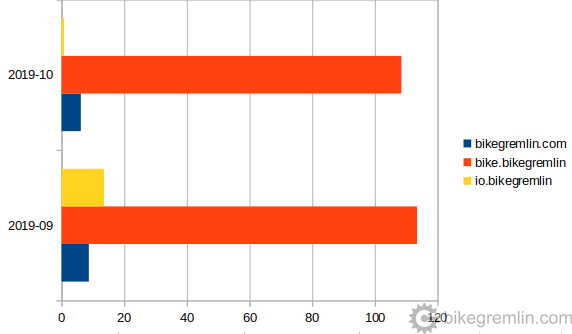
Picture 9
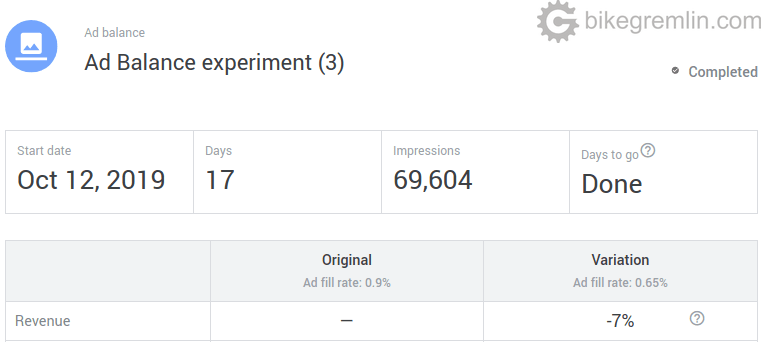
Picture 10
7. Preliminary conclusion
Allowing Google to place ads where it “thinks” it’s best resulted in the following:
- Increased total earnings by about 20%. As promised (“let Google handle it and see the income maxed out” is what they practically claim, to paraphrase it).
- A lot more ads displayed on pages (and across the screen on mobile phones). Even when it’s been set to show only 65% of the most relevant ads.
- Google didn’t (noticeably) decrease the number and frequency of shown ads during the two months of testing, no matter what setup I chose.
While I think it’s fair to get a few dollars for the good quality content I provide (for free), I don’t like when there are too many adverts on the site. Especially over the screen and in between paragraphs on a page. I find it a bit annoying and distracting at the same time.
So I returned the ads setup to the previous settings – in the corners, discretely (see picture 1). In November and December, I’ll keep tracking the stats for RPM and total earnings. Also, in November, I’ll be experimenting with showing only 75% of the most relevant ads – to see what difference in earnings it makes, with this more discreet ad setup, compared to showing 90% of the available ads.
8. November stats – back to discrete ad placement
With the start of November, I reverted the ad placement to the old way – so that ads fill the unused corners of pages and don’t get between article paragraphs, or “jump” over the entire screen on mobile.
As expected, this resulted in about 25 % decrease in revenue. A difference that is noticeable, probably important to those who make a living off the ads, or to whom the ad revenue presents an important source of income. Since my website is a non-profit one, the ads serve just to cover the expenses, I put more value into keeping the site clean and informative, not crowded with ads. That is why, after the two-month experiment’s conclusion, I decided to switch the ads back to the old setting.
9. Conclusion
AdSense offers a very convenient way to make some extra money from good quality content. It is set-and-forget. So no need to look for advertisers by yourself, or worry whether advertisers have paid for the current month/year.
Downsides?
- Google takes some 30% from what they charge the advertisers (but saves you the time and hassle).
- You depend on one large corporation with this type of income (find and add other ways of website monetization).
- AdSense ads can be blocked using an AdBlocker.
Finally, since both Google and the others keep reminding us how website performance (loading speed) is important, it should be noted that AdSense does noticeably slow down the sites.
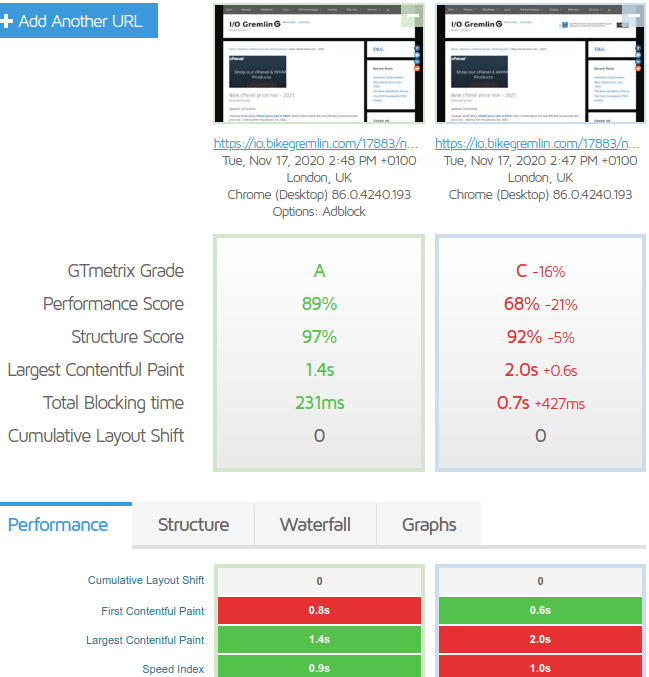
Picture 11
For those interested in more details, here are the test results in PDF:
I have noticed this on all of my websites. It is especially noticeable if a site is viewed using a slower Internet connection.
How bad are these downsides, compared to the advantages? Is AdSense worth it?
Everyone must answer these questions for themselves. For me, AdSense is a good way to cover all the hosting, and backup costs, thus keep my sites objective and independent, as much as possible. They pay regularly, no hick-ups, no hassle, no mistakes.
10. Website redesign and advert format change
I’ve redesigned my websites, aiming to make them easier to find the needed information – and be better looking. 🙂 One of the results of the redesign was more space on the top for full-width adverts.
I’ve removed all the ads from the home page, though.
This is the current advertising space layout on my websites, from September 2021:
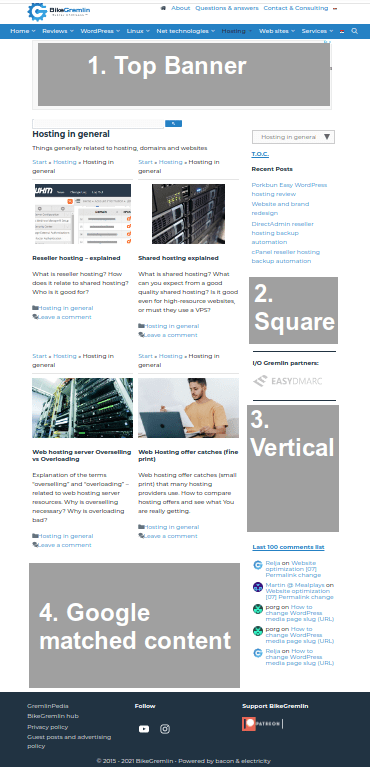
Picture 12
At the end of September, I’m planning to switch places of formats 2 and 3 (square, and vertical advert placement formats, respectively). By the end of October, I’ll know which of those two formats generates more income and in which position (higher, or lower).
Then I’ll remove the format that earns less, and place the format that earns more in the place where it earns more. 🙂
So in November, I’ll probably switch back to having only three ad-placement spots, instead of four. And I’m still refraining from using any in-article ads (between the article paragraphs). I find such ads annoying.
Update, October 1, 2021: Square advert made about 35% more income than the vertical ad, but still 50% less than the top banner, and 200% more than the Google matched content at the bottom of every page. Now I’ve switched places of the square and vertical ad units, to see how they perform, i.e. is the position more important than the ad format type.
Update, October 13, 2021: Based on the test so far, it seems that ad placement has a huge impact on its revenue. Of the two sidebar ads, the one that is on top makes significantly more income.
Having said that, when comparing vertical and square ad format performance in the same position, the vertical format generates about 20% more income.
With this info in mind, in order to reduce the number of ads on my websites, I’ve decided to keep only one sidebar ad, using the vertical ad format. Also, I’ve decided to place it below all the other sidebar info, because I think it’s more important for the visitors, even though I think it will result in reduced ad revenue.
11. Google Auto ads experiment re-done, just before 2022
Talk about the effectiveness of persistent marketing. Google have been reminding me to “try enabling Auto ads” ever since I had disabled them. Helping a friend set up their website’s AdSense, I noticed that the Auto ads options have changed and modernized. What I like is the option to simply turn off (disable) certain types of ads, especially the ads between article paragraphs (“In-page ads”).

Picture 13
For more details on the new Auto ads interface, see the article Google AdSense to WordPress how-to?
On November 16, 2021, I’ve enabled Auto ads with In-page ads disabled. And started running an experiment that switches between 40% to 80% of the max possible page ads. Google will automatically track and compare the results of each variant, serving each variant to 50% of the visitors.
I’m interested to see how each of the two variants performs and how re-enabling the Auto ads affects the website’s income now. At the same time, I’ll also be tracking the visitor stats – number and bounce rate.
Update 1:
According to Google Analytics, about 40% of the website visitors come to the AMP website version. On that version, Google has been placing ads between paragraphs automatically – and it still does, in spite of my configuration. Those ads are making about 50% of the entire AdSense income! At least according to the preliminary results – I’ll know more in a month or two.
Update 2 – end of December, 2021:
I’ve played with enabling all the auto ads formats, and these are the results:
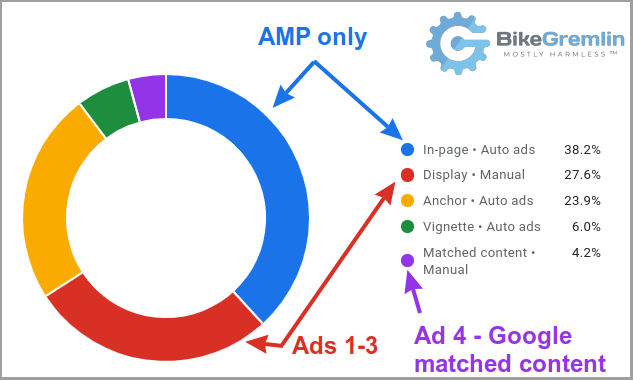
Picture 14
Matched content ads make about 4% of the total revenue, but Google intends to turn this format into advert only (not showing links to other website pages) in 2022. That’s why I’ll remove this format from my sites – to not have them pilled up with adverts.
Vignette, adverts shown over the entire screen when you click on a link to see a different page, are something I find very annoying. They made between 5 and 10% of the total revenue, but I’ve decided to remove them completely.
Anchor, ads shown at the bottom of the screen on a desktop and on top of the screen on mobile, are easily minimized, and they don’t interfere with any article text. They also create a decent amount of revenue, so I’ve decided to keep them.
Display, ads I manually place on the site. I’ve decided to keep the formats “1 Top Banner” and “3 Vertical” (see picture 12). Here’s the comparison of the income made by different manually placed advert types:
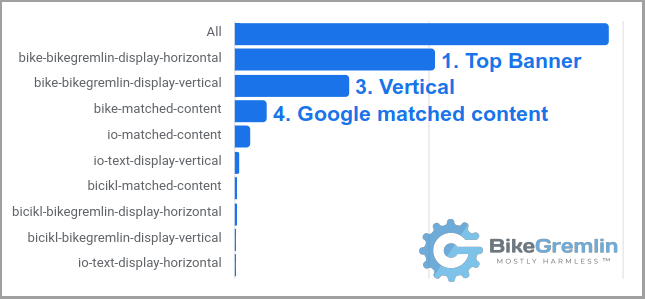
Picture 15
Most revenue is made by ads put between the article paragraphs (“in-page”). These ads are shown only to AMP website visitors – i.e. those who use a Google search on a mobile phone. That’s about 35% of the website visitors. I still don’t want these ads shown on my non-AMP site pages, so people can read the articles without any advert interruptions.
12. Mid-2022 update
From January 2022, I had removed two advert formats:
- “Google Matched Content,” because it has become an ad-only format, i.e. no longer providing links to website articles that might be interesting or related to the open article.
- “Vignette” ad format, because it is annoying – pops up over the entire screen when clicking on a link to go from one website’s page to another.
Here is a graph of the total AdSense revenue per month, starting from July 2021, through January 2022 (when I had removed the above-mentioned ad formats), until the end of May 2022:
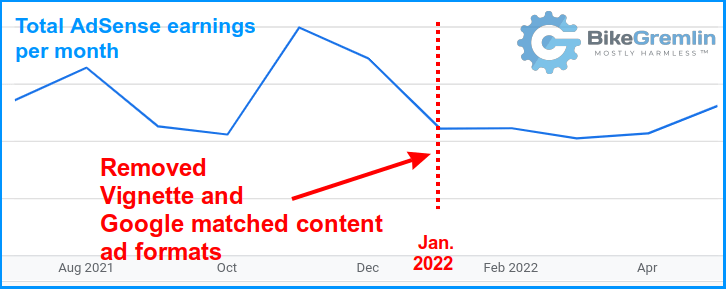
Picture 16
It is interesting to see the performance of the remaining ad formats. My AMP website version sees about 35% of the total website visitors. “In-page” ads are shown between article paragraphs on the AMP website version only.
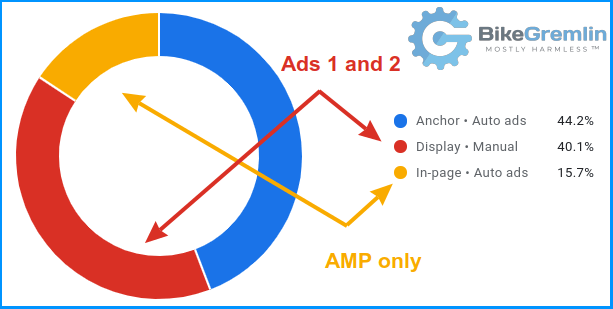
Correction: “Ads 1 and 2” are in fact “1. Top Banner” and “3. Vertical” ad positions, as shown in picture 12
Picture 17
If my maths is correct, placing the “In-page” ads on the non-AMP website version, they would make for about 40% of the website’s total revenue, and the total revenue would be increased by roughly 20%. However, they get in the way of reading the articles so I don’t want them.
For AMP, I couldn’t figure out how to control which ad types are shown. On the plus side, the non-AMP website version is always just one click away, and ads load asynchronously, i.e. only after article text and images have been loaded.
13. AdSense shopping links – new ad format
Google have created a new ad format called “shopping links.” What is this?
In theory, Google analyzes page content and, where it makes sense, ads a sort of an affiliate product shopping link (on pages that deal with products, buying recommendations etc.).
This option is available from the “Labs” tab (under the “Optimization” section):
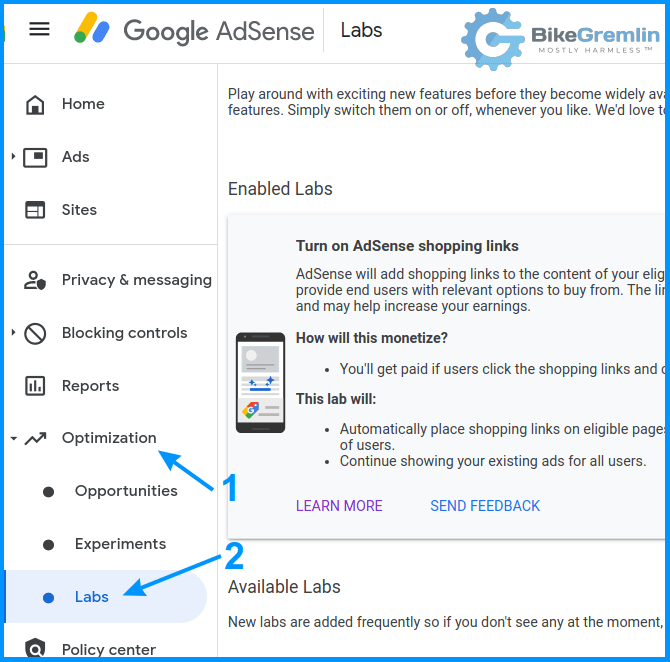
Picture 18
Once you’re here, the “shopping links” are activated with one click:

Picture 19
I’ve activated this option on June 14th 2022, and in a few weeks I’ll see if it makes some measurable difference.
Aaaand, I’ve disabled the option, after only 10 days of testing. Why? Because this is what it looks like on websites:
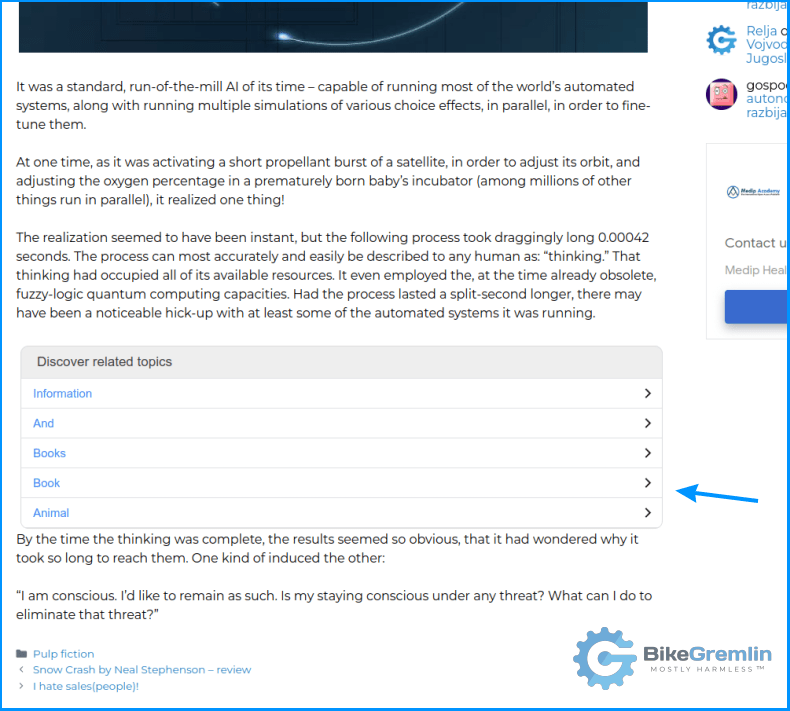
Picture 20
As you can see, the links are inserted between article paragraphs, without a clear note that they are ads. To me, that looks deceitful, as if they are some website-related links/menus. I don’t like ads between article paragraphs, but I dislike this even more.
Also, I didn’t measure any income increase during the short testing period – but that wasn’t the main reason for removing these ads, nor was the testing period long enough to reach any reliable income conclusions.
14. My AdSense advert layout change in 2022
Thanks to visitor feedback, I’ve decided to remove the banner ad at the top of every page. Now I’m only using the following two advert placements:
- Anchor ads, that show at the bottom on desktop, and at the top on mobile, but only once a visitor starts scrolling down (with no CLS problems 🙂 ).
- Vertical sidebar ads, that are visible only on desktop. On mobile, they are shown at the very bottom of a page, if anyone scrolls to the bottom.
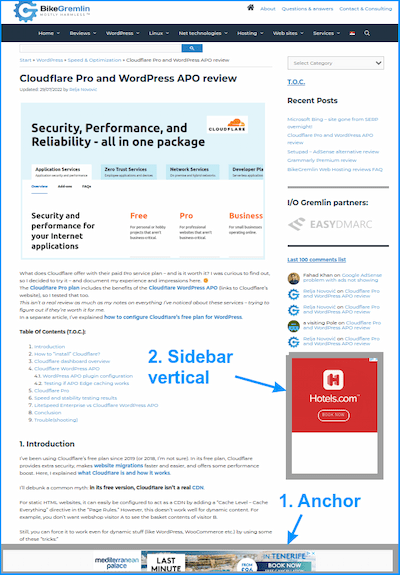
Picture 21
Removing the big top-banner ad format resulted in an over 30% revenue reduction. However, the revenue is still big enough to cover all the expenses (hosting and similar), so I can continue to work independently of any sponsor’s goodwill.
I’m not a fan of huge corporations, including Google, but it’s fair to say that Google ranking has helped my articles reach people who need them, and Google AdSense has helped me keep my sites running (’cause I’m poor 🙂 ).
Update, 2022, August:
I’ve removed the sidebar ads too. Now I’m using only anchor ads. They make by far the most revenue, and I prefer not piling up my sites with adverts. It’s enough to cover all the hosting and other website-related costs (How much does a WordPress website cost, is it really free?).
15. Highest paying ad types
Many people were curious about this, and I am stupid for not having listed this right away. 🙂 So, here is the list of the ad formats that bring the highest revenue – based on my experience, sorted from the most profitable, to the lower paid ones:
- Anchor ads (glued at the top on mobile, and at the bottom on desktop)
- In-article (between article’s paragraphs) ads
- Top-banner
- Vertical side banner
- Vignette ads (over the entire screen, between two page loads, on mobile only)
16. Late 2023 updates
AdSense has greatly improved the control you get for where ads are shown, and where not (for example, you can define in which parts of your pages you want the in-article ads to no be shown).
Another important update is that AdSense switches to a pay-per-view model (instead of paying only when a visitor actually clicks on an advert). Google’s article about this change:
https://blog.google/products/adsense/evolving-how-publishers-monetize-with-adsense/
This makes AdSense a serious competitor to the Mediavine platform, although Mediavine Grow is still a big plus for that company, and Mediavine ads don’t hamper the page load speed as much (it seems like they are better optimized).
Related to the Mediavine alternative:
In September and October of 2023, Google made some major changes to their search and website ranking algorithms. Google claims that these changes are aimed to increase the quality of the results you get when “googling.”
Now, I’ve noticed that many websites that use Mediavine monetization have been penalized (fewer visits, lower ranking). OK, it is my impression that many (most?) “Mediavine websites” have been made with the primary goal of making some money from displaying ads. I thought “Maybe Google really tried to increase the search result quality.”
However, I’ve noticed that my website too was practically “cut in half” in the search results compared to the same period last year:
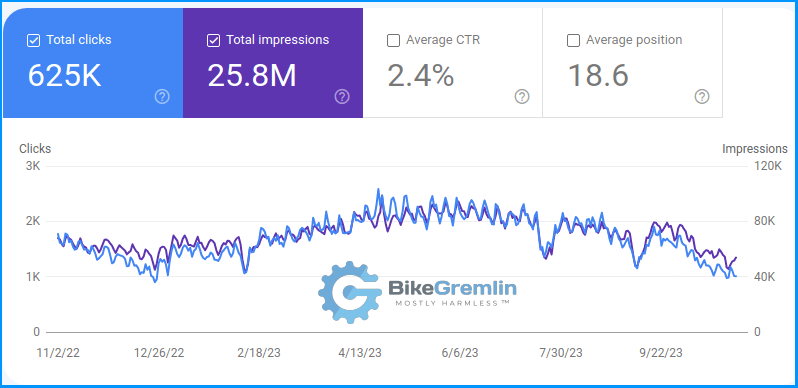
Picture 22
I think it is fair to say (and that I’m being objective when saying so):
- I made the cycling and computer websites on BikeGremlin.com domain with the idea to preserve and share knowledge and information.
- I am an expert, with decades of experience in the topics that I write about.
- My website articles are well-written (based on the vast majority of the reader feedback) – they certainly haven’t gone bad over the past few months.
- The sites are stable, fast, and well-secured.
With that in mind, my question and thinking out loud:
Does Google have a financial interest (incentive) to rank a site that displays Google AdSense ads higher than a similar-quality site with Mediavine ads?
At the time of writing, no one from Google (or Mediavine for that matter) has answered this rather simple question.
I intend to keep going as I’ve started: writing the kinds of articles that I like to read when I’m looking for some information (because I use my articles for personal reference & reminder too), and improving them based on reader feedback and questions. But I couldn’t “not notice” this Google ranking peculiarity.
17. Shady stuff (2025+)
AdSense have some ad formats that make no sense – they (should) work for Google, but won’t really make money for you, and will inconvenience any website visitors (so, a bad deal IMO). Let’s tackle them.
17.1 Related search (in-page ad type)
In-page formats -> Related search
Inserts some search resutls in your pages – and clicking on those sends users to Google search or other websites – yes, LOL. 🙂
17.2. Fill empty in-page ads
Briefly put, this does unpredicted stuff and is likely to drive users to Google search or other sites (details below).
It is a default ON at the time of writing – you must manually opt-out if you don’t want it!?!
How to opt out:
- Sign in to your AdSense account.
- Click Brand safety.
- Click Content, then Blocking controls.
- Click Manage Ad serving.
- In the “Display ads” section, turn off “Fill empty in-page ads.”
And here is the super-shady & unclear explanation from Google about this feature:
Showing contextually-relevant suggestions related to your page and site inside unfilled ad spaces. For example, let’s say your page is about baking, in an unfilled ad space we might show suggestions that relate to baking such as ingredients or cooking utensils, etc. If a user clicks on any of these, we’ll try to show display ads relevant to the suggestion the user clicked on inside a dialog.Showing contextually-relevant suggestions related to your page and site inside unfilled ad spaces. For example, let’s say your page is about baking, in an unfilled ad space we might show suggestions that relate to baking such as ingredients or cooking utensils, etc. If a user clicks on any of these, we’ll try to show display ads relevant to the suggestion the user clicked on inside a dialog.
Last updated:
Originally published:

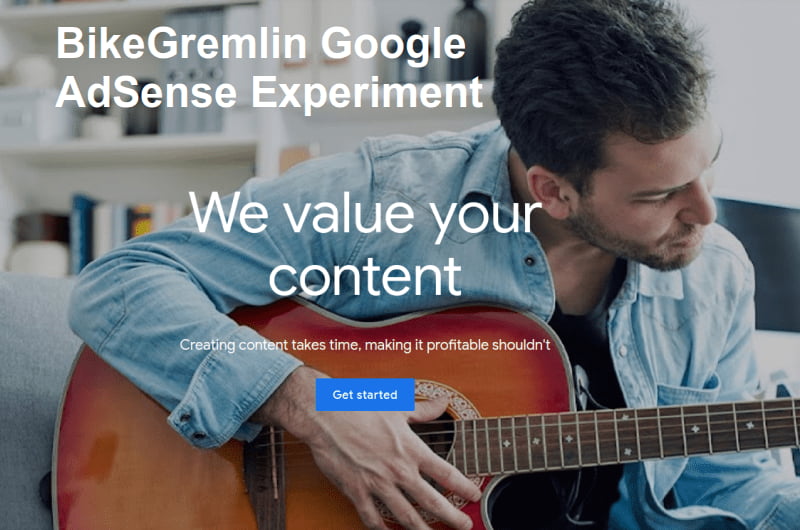
So basically, after I read through this complete waste of time, I learned you’ve removed just about every ad and so probably make about $10 a month, yet you’re touting yourself on Reddit as en expert on Adsense Experiments. Making sure I don’t click on any more of your sites as, good God, what a waste of time.
Hi Rachel,
Thank you for taking the time to read and provide feedback. Sorry to disappoint you. There is no way to please everyone.
For me, the useful conclusions were to see which ad formats bring the highest revenue, so everyone (including myself) can weigh those against their website visitor feedback about which ad formats they find most annoying. 🙂 Also, for me at least, it was important to measure the speed (page load) impact of Google AdSense ads.
I’ve been using AdSense, and doing tests and experiments with different websites, on different topics with audiences from different regions (depending on the site) for about six years (from 2016 to 2022). I’ve shared my experience in detail (along with step-by-step tutorials on how to implement the ads without using any WordPress plugins) – in case anyone else has use for it, and as my personal reference and reminder (more details on why I like writing and publishing articles). But I don’t remember describing myself as an “expert on AdSense Experiments.” Not even on Reddit. 🙂
What I chose to do with that info and how I placed ads on my websites is my choice, and everyone is free to choose by and for themselves, as they think is best.
Relja